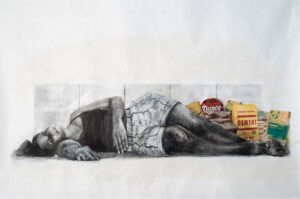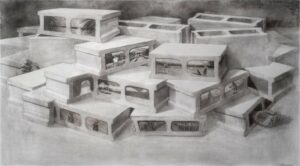Letter from Kingston by Annie Paul
Annie Paul’s ‘Letter from Kingston’, published in our latest spring issue, Wasafiri 117: The State of the Industry, compares the global recognition of Jamaican writers and visual artists, highlighting the disparity in their success and the debates surrounding Jamaican writers and artists who choose to remain in the Caribbean versus those who emigrate, focusing on the complexities and nuances of this decision.
The article prompts reflection on the different pathways to global recognition and advocates for critical assessment of visual art and writing on its own terms, as well as discussing the historical and contemporary context of Caribbean literature through themes of migration, displacement, and the diaspora and offering a critique of societal trends.
Read and download the article in full on the Taylor & Francis website throughout May, or order our latest issue to read it in print.
As I prepare to compose this letter in late 2023, having just returned from showcasing Caribbean writing at the House of World Cultures in Germany, I’m struck by the seemingly opposing strategies employed by Jamaican writers and visual artists in making and circulating their work. Is it possible to do justice to such different fields of aesthetic activity in one epistle? For instance, to get a sense of the art scene, a random series of events and actions, earnestly, if cautiously, executed in the name of visual art must be collated and critically assessed. By and large such events seem to be oblivious of both an external gaze and international trends and appear mainly to be addressing local art enthusiasts.
Only a few Jamaican artists have made their mark globally — for example, Ebony G Patterson, the Rihanna of Jamaican/Caribbean visual art as it were, or the fast-rising Jacqueline Bishop and Deborah Anzinger, the latter Simone Leigh’s choice for the Artist-to-Artist initiative featuring a solo exhibition of new works at Frieze London, 2023. With these exceptions, Jamaican artists have not been curated into major global exhibitions of art in recent years in the way that Trinidadian and Barbadian artists have. To put it bluntly: internationally, Jamaican art has the footprint of a jerboa.
Jamaican writers, on the other hand, seem much more connected to events and debates occurring regionally and internationally — confidently entering global competitions such as the Commonwealth Short Story Prize and placing in the top five. Between 2020 and 2022 only, Jamaican writers resident in Jamaica (Brian Heap, 2020; Roland Watson-Grant, 2021; and Diana McCaulay, 2022) won the regional section of this prize, and, in recent years, Jamaican writers in the diaspora have won major global awards such as the Booker Prize (Marlon James), the Forward Prize in Poetry (Kei Miller), and the plush and prestigious Windham–Campbell Prize (Kwame Dawes, Ishion Hutchinson, and Jamaica-based Erna Brodber). Using awards and competitions as a measure, it’s easy to see that Jamaican writing is hugely successful by any standard.
Another gauge or benchmark is the amount of media attention and international press a writer or artist gets. For instance Safiya Sinclair’s memoir, How to Say Babylon, is at the time of writing being prominently featured in reviews, interviews, and articles in the New York Times, The New Yorker, The Washington Post, NPR, the BBC, Guardian, and Vogue. But is it fair to apply such exacting critical criteria to the art world? The international art world has notoriously been one of the last to reluctantly expand its gaze beyond Euro-American art (as Wainwright has observed, ‘The Caribbean is a region that art history has hardly noticed’ (Timed Out 1)). Why, then, should those of us outside its very narrow ambit engage with such a restricted and restrictive framework? Can we examine and critically assess the various visual art interventions taking place in Jamaica on their own terms?
Picturing the Postcolonial
Let’s start by looking at the most recent exhibition at Jamaica’s well-known art school, the Edna Manley College of Visual Arts, popularly referred to as Edna (after its founder Edna Manley, the high priestess of Jamaican art) – On Drawing – a show of drawings by some of the tutors at the school mounted in time for the college’s annual Rex Nettleford Arts Conference, 11–13 October 2023.
The Cage Gallery, the exhibition space of Edna, was unmanned and stiflingly hot in the middle of the day — not exactly conducive to gazing at the walls for any length of time. Apart from Prudence Lovell’s work on the floor, all the drawings were two-dimensional and conventionally mounted for viewing. Despite the choice of such a conventional medium, some artists had chosen anything but conventional subject matter. Camille Chedda’s drawings made an impression with their horizontal propositions about cement, nation-building, and gendered bodies, while Phillip Thomas’s vertical compositions offered glimpses into his complex pluriverse of signs, symbols, and subjects.
Chedda’s deft, sure-footed mark-making in charcoal renders its weighty subject matter ethereal and atmospheric. In the first drawing, a female body, heavy with sleep (or death?), lies prone across the horizontal plane against a short wall made of cement blocks. Her head, tilting, rests on the ground like the rest of her body, one arm folded across her midriff, the other reaching towards the viewer, foreshortened. In a familiar attitude of sleep, the woman’s legs are bent at the knee and behind the slope of her shorts-clad thighs are clumped a number of bags, along with a sign bearing the word ‘Dunce’. Labelling on some of the bags indicates they contain ‘general-purpose cement’, a material Chedda has focused on heavily in recent work. Except for the bags, the drawing is in black and white. Titled ‘Cemented’ the drawing subtly raises questions about transience, permanence, home and homelessness, citizenship, and belonging (Figure 1).
FIGURE 1. CAMILLE CHEDDA, ‘CEMENTED’, 2023. CHARCOAL, ACRYLIC, AND COLLAGE ON PAPER. 91.44 CM × 133.35 CM.
In August 2023, with schools set to reopen in September, a worthy citizen raised the alarm about schoolbags bearing the word ‘dunce’ being prominently displayed in the style of a fashion statement, a brand, or logo. What ensued could be best described as moral panic. A chorus of scolds voiced fears that using the D-word in this way would produce a nation of dunces and recommended that children bringing such bags to school be barred from class until they complied with the ‘no dunce’ policy. A few moderate voices tried in vain to suggest that it was barring children from school that would result in duncery but the confederacy of dunces continued full throttle.
In several of her recent works, Chedda has wagged a sententious finger at popular or dancehall trends that appear to defy the logic of respectability and responsibility demanded by the national modern. Her use of cement and cement blocks references a trend in 2015 that saw female dancers seemingly battering their vaginas or pubic areas with blocks of cement (Anonymous).
In another work titled ‘Build’, several hollow cement blocks are loosely aggregated in a pile, while the extremities of a black body seemingly buried beneath them protrude here and there (Figure 2). The double cores or hollows of the blocks contain images of a touristy sunset, a great house, the familiar nude figures of the Emancipation monument, the beach, cane fields, golfers on a golf course, colonial statuary, and similar tropes and sights/sites of the postcolonial nation. Chedda’s black and white palette traps the sentimental images in cement frames, the accumulated weight of which crushes the black body underneath. Perhaps it is a commentary on Jamaican society and its outcasts.
FIGURE 1. CAMILLE CHEDDA, ‘CEMENTED’, 2023. CHARCOAL, ACRYLIC, AND COLLAGE ON PAPER. 91.44 CM × 133.35 CM.
Read and download the article in full on the Taylor & Francis website throughout May, or order our latest issue to read it in print.
We start our 40th anniversary year with Wasafiri 117, which has a special focus on ‘The State of the Industry’. Our spring 2024 issue reflects on the contemporary international literary industry through a variety of perspectives, from publishing to academia, via the work of writing, translating, editing, publishing, and teaching.

